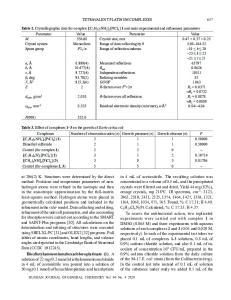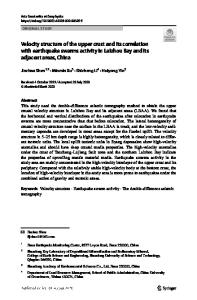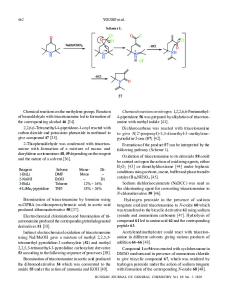Dexoxadrol and its bioisosteres: structure, synthesis, and pharmacological activity
- PDF / 2,543,790 Bytes
- 47 Pages / 612 x 792 pts (letter) Page_size
- 71 Downloads / 330 Views
1625
Dexoxadrol and its bioisosteres: structure, synthesis, and pharmacological activity I. A. Novakov,a D. S. Sheikin,a M. B. Navrotskii,a A. S. Mkrtchyan,a L. L. Brunilina,a and K. V. Balakinb aVolgograd
State Technical University, 28 prosp. Lenina, 400005 Volgograd, Russian Federation. E-mail: maxim.nawrozkij@vstu.ru bKazan (Volga Region) Federal University, 18 ul. Kremlevskaya, 420008 Kazan, Russian Federation The review addresses the complete anthology of the development and evolution of dexoxadrol derivatives comprising a class of highly efficient NMDA receptor antagonists. Main approaches to the synthesis of dexoxadrol and enantiomeric 1-(2-piperidyl)ethane-1,2-diols and their structural relationship with natural alkaloids from plants of the genera Conium and Astrogalus are considered. Data on biomolecular mechanisms of action of this type of compounds are summarized. The relationships between their chemical structure and biological activity are analyzed. Based on the revealed relationships, different pathways of targeted modifications of the chemical structures of dexoxadrol and its analogues are suggested, which would help in future in overcoming the limitations associated with this type of physiologically active compounds, such as insufficient affinity for the channel binding site of the NMDA-receptor ionophore complex, low hydrolytic stability, anticholinergic side effects, and the production of toxic metabolites. These modifications will make it possible to utilize in full measure the great pharmacological potential of this type of compounds. Key words: dexoxadrol, etoxadrol, antidepressants, NMDA receptors, enantioselectivity, structure—activity relationship, biomolecular mechanisms of action, bioisosterism.
Introduction According to the World Health Organization, depression (depressive disorders) is one of the most serious global health problems.1 There are several definitions for depression, different hypotheses being proposed to account for the predominant biomolecular mechanism for the development of this disorder. The monoaminergic theory of the development of depressive disorders has long been the most popular one. In this theory, compounds that directly or indirectly affect adrenaline, noradrenaline, dopamine, and particularly serotonin receptors are considered as playing a key role in the development and pharmacological correction of depressive disorders. However, in recent years, the possibility of influencing receptor ionophore complexes sensitive to neurotransmitter amino acids has been considered as an important factor in the pharmacological correction of depressive disorders.2 The approval of the S-isomer of ketamine by the Food and Drug Administration (FDA) of the United States3 as a nasal spray4,5 and its use in clinical practice led to a breakthrough in the development of antidepressants with immediate effect. The role of the NMDA receptor (glutamate receptor selectively bound to N-methyl-D-aspartate), the AMPA
receptor (-amino-3-hydroxy-5-methyl-4-isoxazolepropionic acid receptor), or th
Data Loading...











